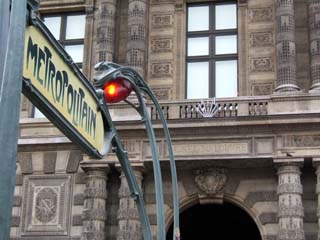 |
The Louvre opens earlier than a lot of the museums in
Paris so I took a few hours to see it. You should laugh because
it would take a week just to have walked through the whole Louvre so I
didn't make much of a dent in what was there. My priority was to
see the ancient art sections but I was disappointed that some exhibits
like the Iranian were closed. I have noticed that European
museums like the Louvre have a better collection of ancient artifacts
than many of the countries where they originally came from. Some
of the items were gifts to dignitaries, private collections that were
donated to the museum, or outright theft from previous wars, doesn't
matter, the result is that there are better examples of Greek art in
the Louvre than at the museum at the Parthenon.
|
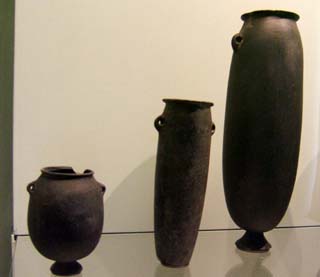
|
Starting at the oldest
section, Egyptian. These small stone vessels, from 5 to 6
thousand years ago, were 2 to 6 inches tall and made out of some of the
hardest stone (basalt). I saw smaller pieces with similar small
loops on the side that still had gold wires running through them to
form a handle. The shape is the same as you might expect from a
clay vessel turned on a potting wheel so I am suspicious that these
stone pieces are precious rarities modeled after common clay vessels
and are not typical of the time but rather just what has
survived. The only way they could have worked this stone at that
time was by slow abrasion. It must have taken months to create
one of these.
|

|
These heads are only
half as old so the technique of working very hard stones was well
worked out by then. Most of Egyptian art revolves around death
and these were described as commissions for tombs. Their small
size seems to indicate that they represent people of only intermediate
political importance. (We've all seen the stuff that celebrate
the Egyptian royalty so I won't dwell on it here.) These
portraits seemed more lifelike to me than the stylized royal portraits.
|
 |
I was surprised to see
several wooden pieces that were thousands of years old. Some were
in near perfect condition. This couple was over 4000 years
old. I have always been convinced that there must have been art
for the common people that simply didn't survive as well as the royal
and funeral related stuff but I have little evidence of that. To
my eye though, this seems like a happy couple.
|
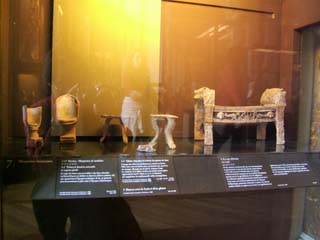
|
The Greeks were a
little better about depicting the common lifestyle but these miniatures
from just before the time of Christ are still rare. They were
described as "Thrones" but I'm suspicious that they are just
furniture.
|

|
Ok. One can't go
into the Greek section of the Louvre without paying homage to Venus de
Milo. I had to wait until a long line from a Japanese Tourist bus
passed by with each person posing in front of her. I suspect that
nearly everyone who has visited this part of the Louvre has a picture
of Venus in some form. That makes her pretty close to my idea of
a common experience of art.
|
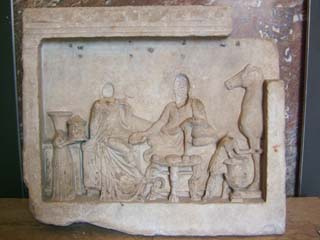
|
A lot of surviving
sculpture from the Greeks is funeral stuff and some pieces like this
one seem to have been mass produced to be ready to insert your loved
one's portrait into the available slot. Not everybody has the
opportunity to plan ahead you know.
|

|
Getting a little
closer to what I was looking for, I discovered this mold which was
intended for mass producing terra-cotta figures. They were easy
to make and so must have been affordable. The description in the
museum admitted they didn't know exactly what these figures were used
for but I suspect that they were hocked on the corner like tourist
trinkets so everybody had one.
|
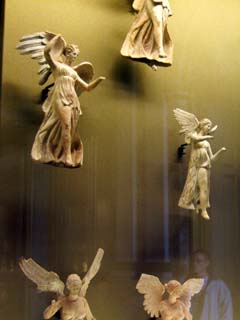 |
One fun discovery for
me was Nike because she has been so thoroughly adopted as the modern
image of the "angel". (Which is odd because I don't think the
Greeks even wore underwear).
|
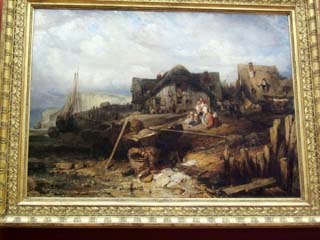 |
The "French
Painters" section was mostly biblical scenes and portraiture of
aristocrats but there were a few depictions of the life of the common
people (even if they were probably romanticized). After seeing
room after room of portraits that were intended to capture a person for
posterity and religious images that dealt with the afterlife I found
myself hungry for paintings that celebrated life.
|

|
In the context
of this huge archive of old art it was refreshing to see someone
actually creating art.
In the small portion of the Louvre that I visited there were perhaps a
dozen painters like this one who were copying works on display.
It was great to see someone willing to spend hours if not days or weeks
with one painting rather than being so overwhelmed by the dozens in
every room. It was sort of like visiting the umpteenth empty
cathedral and finally meeting someone who was actually praying.
A few hours of the Louvre was enough for this trip.
I headed back out to the streets.
|










